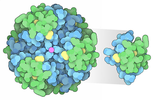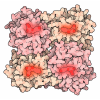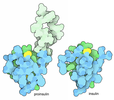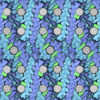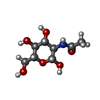[English] 日本語
 Yorodumi
Yorodumi- PDB-9ef4: Cryo-EM structure of Drosophila melanogaster insulin receptor (dm... -
+ Open data
Open data
- Basic information
Basic information
| Entry | Database: PDB / ID: 9ef4 | |||||||||||||||||||||
|---|---|---|---|---|---|---|---|---|---|---|---|---|---|---|---|---|---|---|---|---|---|---|
| Title | Cryo-EM structure of Drosophila melanogaster insulin receptor (dmIR) bound with two DILP1, symmetric conformation | |||||||||||||||||||||
 Components Components |
| |||||||||||||||||||||
 Keywords Keywords | STRUCTURAL PROTEIN / Insulin receptor / DILP | |||||||||||||||||||||
| Function / homology |  Function and homology information Function and homology informationprimary spermatocyte growth / negative regulation of peptide hormone secretion / Extra-nuclear estrogen signaling / response to anoxia / negative regulation of entry into reproductive diapause / Insulin signaling pathway / Insulin receptor recycling / female mating behavior / embryonic development via the syncytial blastoderm / male germ-line stem cell asymmetric division ...primary spermatocyte growth / negative regulation of peptide hormone secretion / Extra-nuclear estrogen signaling / response to anoxia / negative regulation of entry into reproductive diapause / Insulin signaling pathway / Insulin receptor recycling / female mating behavior / embryonic development via the syncytial blastoderm / male germ-line stem cell asymmetric division / female germ-line stem cell population maintenance / germ-band shortening / carbohydrate homeostasis / germ-line stem-cell niche homeostasis / imaginal disc growth / open tracheal system development / positive regulation of neuron remodeling / germ-line stem cell division / negative regulation of circadian sleep/wake cycle, sleep / lymph gland development / follicle cell of egg chamber development / positive regulation of border follicle cell migration / female germ-line stem cell asymmetric division / positive regulation of fat cell proliferation / intestinal stem cell homeostasis / growth cone membrane / positive regulation of organ growth / positive regulation of lipid storage / insulin receptor complex / regulation of organ growth / insulin receptor activity / embryo development ending in birth or egg hatching / positive regulation of multicellular organism growth / insulin binding / triglyceride homeostasis / negative regulation of feeding behavior / positive regulation of wound healing / negative regulation of macroautophagy / positive regulation of neuroblast proliferation / female gonad development / lipid homeostasis / insulin receptor substrate binding / regulation of multicellular organism growth / developmental growth / positive regulation of cell size / phosphatidylinositol 3-kinase binding / positive regulation of TORC1 signaling / axon guidance / cholesterol homeostasis / cellular response to starvation / determination of adult lifespan / insulin receptor binding / response to cocaine / locomotory behavior / circadian rhythm / receptor protein-tyrosine kinase / hormone activity / SH3 domain binding / multicellular organism growth / insulin receptor signaling pathway / nervous system development / glucose homeostasis / regulation of cell population proliferation / protein autophosphorylation / positive regulation of cell growth / response to oxidative stress / protein tyrosine kinase activity / protein phosphorylation / positive regulation of phosphatidylinositol 3-kinase/protein kinase B signal transduction / positive regulation of MAPK cascade / axon / positive regulation of cell population proliferation / extracellular space / extracellular region / ATP binding / metal ion binding / identical protein binding / plasma membrane Similarity search - Function | |||||||||||||||||||||
| Biological species |  | |||||||||||||||||||||
| Method | ELECTRON MICROSCOPY / single particle reconstruction / cryo EM / Resolution: 3.9 Å | |||||||||||||||||||||
 Authors Authors | Bai, X.C. | |||||||||||||||||||||
| Funding support |  United States, 1items United States, 1items
| |||||||||||||||||||||
 Citation Citation |  Journal: Nat Commun / Year: 2025 Journal: Nat Commun / Year: 2025Title: Structure and activation of the Drosophila insulin receptor by three Drosophila insulin-like peptides. Authors: Kai Cai / Michelle Ng / Rochele R Yamamoto / Mohammed Akhter Hossain / Catherine Hall / John D Wade / Marc Tatar / Eunhee Choi / Xiao-Chen Bai /   Abstract: Insulin/IGF signaling (IIS) is a highly conserved pathway essential for physiological regulation from yeast to mammals. In Drosophila melanogaster, a single insulin-like receptor (dmIR) interacts ...Insulin/IGF signaling (IIS) is a highly conserved pathway essential for physiological regulation from yeast to mammals. In Drosophila melanogaster, a single insulin-like receptor (dmIR) interacts with various insulin-like peptides (DILPs), leading to diverse signaling and functional outcomes. However, the mechanisms by which different DILPs result in varied receptor activation and biological responses remain unclear. Here, we determine the cryo-electron microscopy (cryo-EM) structures of dmIR in complex with three DILPs: DILP1, DILP2, and DILP5. Our structural analyses reveal that each DILP induces distinct conformations of dmIR: the dmIR/DILP5 complex adopts the Ƭ-shaped asymmetric conformation with three bound DILP5 molecules; the dmIR/DILP2 complex displays the Γ-shaped asymmetric conformation with a single bound DILP2 molecule; and the dmIR/DILP1 complex shows both a Γ-shaped asymmetric conformation and a symmetric conformation that resembles a T-shape with a splayed stem. Functional assays demonstrate that the efficacy of DILP-mediated dmIR activation differs, with DILP5 inducing higher levels of receptor autophosphorylation, followed by DILP2 and DILP1. Together, these findings suggest that the distinct interactions between dmIR and DILPs dictate specific patterns of receptor activation. | |||||||||||||||||||||
| History |
|
- Structure visualization
Structure visualization
| Structure viewer | Molecule:  Molmil Molmil Jmol/JSmol Jmol/JSmol |
|---|
- Downloads & links
Downloads & links
- Download
Download
| PDBx/mmCIF format |  9ef4.cif.gz 9ef4.cif.gz | 648.3 KB | Display |  PDBx/mmCIF format PDBx/mmCIF format |
|---|---|---|---|---|
| PDB format |  pdb9ef4.ent.gz pdb9ef4.ent.gz | 513.3 KB | Display |  PDB format PDB format |
| PDBx/mmJSON format |  9ef4.json.gz 9ef4.json.gz | Tree view |  PDBx/mmJSON format PDBx/mmJSON format | |
| Others |  Other downloads Other downloads |
-Validation report
| Summary document |  9ef4_validation.pdf.gz 9ef4_validation.pdf.gz | 1.9 MB | Display |  wwPDB validaton report wwPDB validaton report |
|---|---|---|---|---|
| Full document |  9ef4_full_validation.pdf.gz 9ef4_full_validation.pdf.gz | 1.9 MB | Display | |
| Data in XML |  9ef4_validation.xml.gz 9ef4_validation.xml.gz | 57.7 KB | Display | |
| Data in CIF |  9ef4_validation.cif.gz 9ef4_validation.cif.gz | 86.8 KB | Display | |
| Arichive directory |  https://data.pdbj.org/pub/pdb/validation_reports/ef/9ef4 https://data.pdbj.org/pub/pdb/validation_reports/ef/9ef4 ftp://data.pdbj.org/pub/pdb/validation_reports/ef/9ef4 ftp://data.pdbj.org/pub/pdb/validation_reports/ef/9ef4 | HTTPS FTP |
-Related structure data
| Related structure data |  47969MC  9ef1C  9ef5C  9ef9C M: map data used to model this data C: citing same article ( |
|---|---|
| Similar structure data | Similarity search - Function & homology  F&H Search F&H Search |
- Links
Links
- Assembly
Assembly
| Deposited unit | 
|
|---|---|
| 1 |
|
- Components
Components
| #1: Protein/peptide | Mass: 4243.928 Da / Num. of mol.: 2 / Source method: obtained synthetically / Source: (synth.)  #2: Protein/peptide | Mass: 3025.562 Da / Num. of mol.: 2 / Source method: obtained synthetically / Source: (synth.)  #3: Protein | Mass: 240078.078 Da / Num. of mol.: 2 Source method: isolated from a genetically manipulated source Source: (gene. exp.)   Baculovirus expression vector pFastBac1-HM Baculovirus expression vector pFastBac1-HMReferences: UniProt: P09208, receptor protein-tyrosine kinase #4: Sugar | ChemComp-NAG / Has ligand of interest | Y | Has protein modification | Y | |
|---|
-Experimental details
-Experiment
| Experiment | Method: ELECTRON MICROSCOPY |
|---|---|
| EM experiment | Aggregation state: PARTICLE / 3D reconstruction method: single particle reconstruction |
- Sample preparation
Sample preparation
| Component | Name: Drosophila melanogaster insulin receptor in complex with two DILP1, symmetric conformation Type: COMPLEX / Entity ID: #1-#3 / Source: RECOMBINANT |
|---|---|
| Source (natural) | Organism:  |
| Source (recombinant) | Organism:  Baculovirus expression vector pFastBac1-HM Baculovirus expression vector pFastBac1-HM |
| Buffer solution | pH: 7.4 |
| Specimen | Embedding applied: NO / Shadowing applied: NO / Staining applied: NO / Vitrification applied: YES |
| Vitrification | Cryogen name: ETHANE |
- Electron microscopy imaging
Electron microscopy imaging
| Experimental equipment |  Model: Titan Krios / Image courtesy: FEI Company |
|---|---|
| Microscopy | Model: TFS KRIOS |
| Electron gun | Electron source:  FIELD EMISSION GUN / Accelerating voltage: 300 kV / Illumination mode: FLOOD BEAM FIELD EMISSION GUN / Accelerating voltage: 300 kV / Illumination mode: FLOOD BEAM |
| Electron lens | Mode: BRIGHT FIELD / Nominal defocus max: 2200 nm / Nominal defocus min: 800 nm |
| Image recording | Electron dose: 50 e/Å2 / Film or detector model: GATAN K3 BIOQUANTUM (6k x 4k) |
- Processing
Processing
| EM software |
| ||||||||||||||||||||||||||||||||||||
|---|---|---|---|---|---|---|---|---|---|---|---|---|---|---|---|---|---|---|---|---|---|---|---|---|---|---|---|---|---|---|---|---|---|---|---|---|---|
| CTF correction | Type: PHASE FLIPPING AND AMPLITUDE CORRECTION | ||||||||||||||||||||||||||||||||||||
| 3D reconstruction | Resolution: 3.9 Å / Resolution method: FSC 0.143 CUT-OFF / Num. of particles: 25580 / Symmetry type: POINT | ||||||||||||||||||||||||||||||||||||
| Refinement | Highest resolution: 3.9 Å Stereochemistry target values: REAL-SPACE (WEIGHTED MAP SUM AT ATOM CENTERS) | ||||||||||||||||||||||||||||||||||||
| Refine LS restraints |
|
 Movie
Movie Controller
Controller





 PDBj
PDBj


